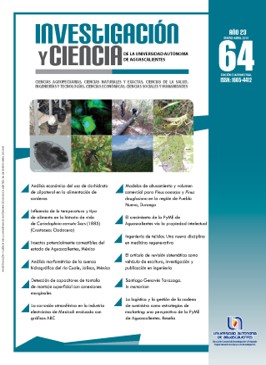Tissue engineering. A new discipline in regenerative medicine
DOI:
https://doi.org/10.33064/iycuaa2015643597Keywords:
engineered tissues, tissue engineering, regenerative medicine, stem cellsAbstract
Currently scientists around the world are focusing their efforts to find alternatives to replace diseased tissues that do not meet normal organ function satisfactorily. In this context, tissue engineering techniques allow the generation of tissues ex vivo, with the opportunity of being incorporated into the organism and replace damaged or diseased tissue to increase, decrease or change their functions with autologous grafts. These techniques allow replacing human organs currently affected by using engineered grafts generated in the laboratory. This replaces allografts, which in turn can cause rejection, disease transmission and involution of the grafted tissue. Due to the importance of performing the stem cells used for the generation of tissues in the laboratory, this work will address through review of the literature the general aspects of the stem cells or mesenchymal stem cells, biomaterials and growth factors
Downloads
Metrics
References
• FARINI, A. et al. Clinical Applications of Mesenchymal Stem Cells in Chronic Diseases. Stem Cells Int., 2014(2014): 1-11. doi: 10.1155/2014/306573.
• FUJI, S. et al. Possible Implication of Bacterial Infection in Acute Graft-Versus-Host Disease after Allogeneic Hematopoietic Stem Cell Transplantation. Front Oncol., 4: 89, 2014. doi: 10.3389/fonc.2014.00089.
• LEE, S. K. et al. A novel cell-free strategy for promoting mouse liver regeneration: utilization of a conditioned medium from adipose-derived stem cells. Hepatol Int. [Epub 2014 Dec 25]. doi: 10.1007/s12072-014-9599-4.
• MATEOS TIMONEDA, M. A. et al. Effect of structure, topography and chemistry on fibroblast adhesion and morphology. J Mater Sci Mater Med., 25(7): 1781-1787. [Epub ahead of print]. doi: 10.1007/s10856-014-5199-z.
• MENG, X. et al. Stem cells in a three-dimensional scaffold environment. Springerplus, 3: 80, 2014. doi: 10.1186/2193-1801-3-80.
• MUSUMECI, G. et al. New perspectives for articular cartilage repair treatment through tissue engineering: A contemporary review. World J Orthop., 5(2): 80-88, 2014. doi: 10.5312/wjo.v5.i2.80.
• NIH (NATIONAL INSTITUTES OF HEALTH), US DEPARTMENT OF HEALTH AND HUMAN SERVICES. What are adult stem cells? In Stem Cell Information. Recuperado de http://stemcells.nih.gov/info/basics/pages/basics4.aspx>
• SHAPIRA, A. et al. Advanced micro- and nanofabrication technologies for tissue engineering. Biofabrication, 6(2), 2014. [Epub ahead of print]. doi: 10.1088/1758-5082/6/2/020301.
• SMART, N. J. et al. Biologics Porcine dermis implants in softtissue reconstruction: current status. Biologics, 8: 83-90, 2014. Published online 2014 Mar 10. doi: 10.2147/BTT.S46469.
• WUCHTER, P. et al. Standardization of Good Manufacturing Practice-compliant production of bone marrow-derived human mesenchymal stromal cells for immunotherapeutic applications. Cytotherapy, 17(2): 128-139. doi: 10.1016/j.jcyt.2014.04.002.
• YILDIRIMER, L. y SEIFALIAN, A. M. Three-dimensional biomaterial degradation - Material choice, design and extrinsic factor considerations. Biotechnol Adv., 32(5): 984-999. doi: 10.1016/j.biotechadv.2014.04.014.
Downloads
Published
License
Copyright (c) 2015 Deyanira Serrato Ochoa, Renato Nieto Aguilar, Asdrúbal Aguilera Méndez

This work is licensed under a Creative Commons Attribution-NonCommercial-ShareAlike 4.0 International License.
Las obras publicadas en versión electrónica de la revista están bajo la licencia Creative Commons Atribución-NoComercial-CompartirIgual 4.0 Internacional (CC BY-NC-SA 4.0)





